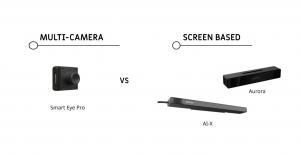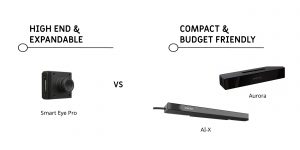EN

Smart Eye develops the world’s most advanced Human Insight AI for analyzing human behavior in complex environments. Thanks to its unparalleled performance in complex situations, our technology offers deep insights into human behavior and human-machine interaction in automotive, aviation, assistive technology, behavioral science and many more fields.
Hundreds of companies, research organizations and universities all over the world use Smart Eye’s eye tracking technology to reach new breakthroughs within behavioral research. Given this broad scope of customers and volume of units sold, we have quite a few eye trackers and other research tools available, and we thought it might be helpful to break down the use and purpose of each eye tracker.

We have two main types of systems: multi-camera (Smart Eye Pro) and screen-based eye trackers (Aurora and AI-X).
Multi-camera eye trackers are flexible because the cameras can be placed anywhere in the environment. These systems can also be expanded upon by adding more cameras with the purchase of covering a larger field of view.
Then our screen-based application products, Aurora and AI-X are compact yet high-performance eye trackers. This means that they are designed for screen-based (screens up to 24”) eye tracking research within marketing, UX and media. The Aurora product is the high end eye tracker that can run in 60, 120 and 250 Hz: The higher the frame rate means research groups can study specific eye movements in more depth for their research studies (read more about that here).
The increased frame rate also reduces the latency of the eye tracker output, or the time from when the actual eye movement occurs to when the data is calculated and output generated from the eye tracker. This low latency is a critical component in interactive psychology research such as gaze contingency research where what is being displayed on the screen depends on eye movements of the subject.
• Easily Update. Realize you need a higher frame rate? No need to send it back: we can push a simple software upgrade that will increase your frame rate up to 250 Hz to get the result you are looking for.
• Quick Set Up. The Aurora is what we refer to as a “bar tracker,” that has 2 cameras but is a single unit. With this single unity comes ease of use, as there is no need to calibrate it: it can be stuck somewhere and you can start using it immediately.

Sometimes you don’t need the state of the art, high-end solution. For those looking for a more compact, budget-friendly option, the more simple AI-X eye tracker is perfect for when you do not want to compromise on the accuracy. The AI-X can be used for all kinds of research but is recommended for marketing, media research, UX, and psychology studies.
Our experience within the automotive industry has taught us all about the importance of having high performing solutions in a cost-effective way. We have taken this knowledge and our 20 years of experience within eye tracking and put it into the development of the AI-X, making it a high performing eye tracker, perfectly suitable for large studies with many subjects.
AI-X’s small footprint makes it very easy to move your studies and research out of a stationary lab, to a more portable lab. Researchers can simply attach the AI-X to a laptop and take their study to where the participants are. AI-X’s design makes it easy to switch between different projects, screens, and situations.
Inside, one state of the art high-definition sensor captures your test participants brilliantly, regardless of light conditions. This eye tracker is available with 60 Hz frame rate, and used by Smart Eye customers such as Smartbox, who use AI-X technology in their Lumin-i product to enable communication for those with disabilities. You can read more about that in the press release here.
In our Smart Eye Pro system, customers are able to have anywhere from 1 to 8 camera set-ups. This capability to manage multiple cameras within a single environment is helpful when you need multiple points of view from all of your cameras at the same time.
Some examples requiring the need for these views include inside a control room, car, or flight deck. Research subjects need to be able to look all around their environment in these instances, and in order to process their data, that person’s face must be visible. Taking an automotive driving simulation as an example, a research project might require a straight-on view of the face. But then 6 months later, the same project needs to collect data of that subject looking at the entertainment console. (No cameras in those positions = no data collected.)
So an eye tracking system must be flexible enough to accommodate these more complex use cases by adding additional cameras and field of view (FOV) angles. The cameras also don’t require a flat surface – anywhere a camera will fit, Smart Eye Pro will have a place for the hardware. This modular system is insensitive or agnostic to any type of ambient light conditions, including visual, Infrared (IR) and Near-Infrared (NIR) lights. It also doesn’t require specific distance or even heights between cameras. That is one of the biggest advantages of Smart Eye Pro, as no other eye tracking system on the market can have multiple cameras working with each other to cover a large field of view.
As the provider of the world’s most advanced remote eye-tracking system, Smart Eye is continually innovating to deliver bigger insights for our customers. So whether you require a complex, multi-camera set up or a more compact, budget-friendly solution, Smart Eye has an eye tracking system that will work for your research project needs.
For more of a deep dive into each of our eye trackers and further discussion on what makes the most sense for you, contact us today.
